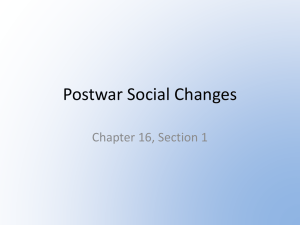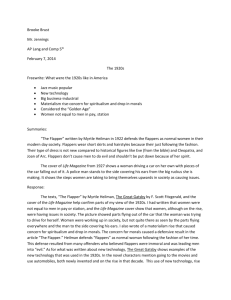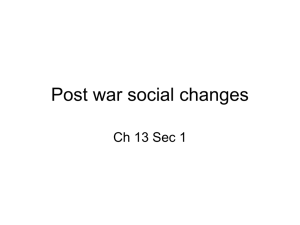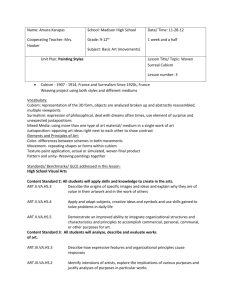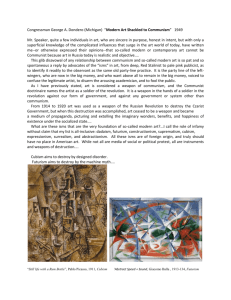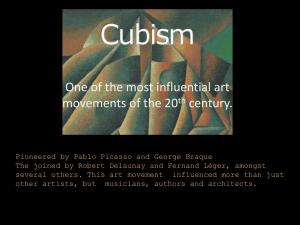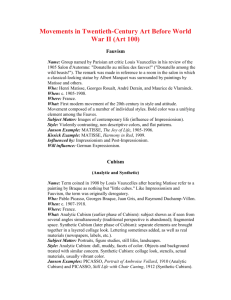31.1 postwar uncertainty
advertisement
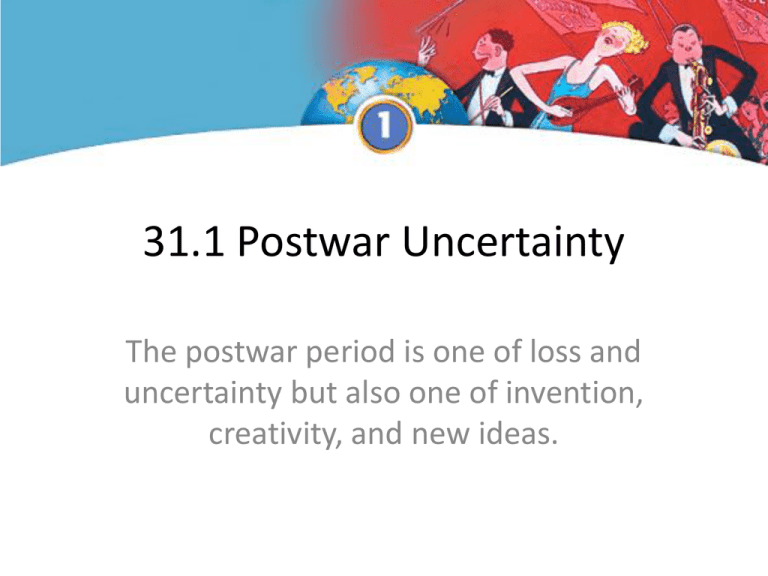
31.1 Postwar Uncertainty The postwar period is one of loss and uncertainty but also one of invention, creativity, and new ideas. A New Revolution in Science • Impact of Einstein’s Theory of Relativity – Albert Einstein offered radically new ideas in field of physics – Theory of relativity— idea that space and time are not constant – New ideas make world seem more uncertain than before A New Revolution in Science • Influence of Freudian Psychology – Sigmund Freud— Austrian doctor with new ideas about the mind – Claims that human behavior is not based on reason Literature in the 1920s: The Lost Generation • Impact of the War – Suffering caused by World War I leads many to doubt old beliefs. – Many American younger postwar writers choosing to live in Europe are called the “Lost Generation,” a term used by Ernest Hemingway in his novel The Sun Also Rises, himself a member of the “lost generation.” The term was coined by his mentor, the writer Gertrude Stein. Lost Generation Writers • T.S. Elliot • Wrote The Waste Land, a poem. Lost Generation Writers • F. Scott Fitzgerald • Wrote the short story “Bernice Bobs Her Hair” as well as the novel The Great Gatsby. Lost Generation Writers • Ezra Pound – an American expatriate poet, critic and a major figure of the early modernist movement. – His best-known works include Ripostes (1912), Hugh Selwyn Mauberley (1920), and his unfinished 120-section epic, The Cantos (1917– 1969). Other Writers • Writers Reflect Society’s Concerns – Novels of Franz Kafka reflect uneasiness of postwar years – Novels of James Joyce reflect Freud’s ideas about the mind Literature in the 1920s • Thinkers React to Uncertainties – Philosophy of existentialism—no universal meaning to life – Friedrich Nietzsche (right) urges return to ancient heroic values . Literature in the 1920s • French philosopher Jean-Paul Satre (right) becomes a leading existentialist philosopher. • Sartre’s partner Simone De Beuvoir (right) is also a existentialist philosopher and feminist author. Sartre and Beuvoir Revolution in the Arts • Artists Rebel Against Tradition • Artists want to depict inner world of mind – Cubism transforms natural shapes into geometric forms – Dadaism—art that rejected reason and logic, prizing nonsense, anarchy, irrationality and intuition – Surrealism—art movement that links dreams with real life Cubism • Pablo Picasso, Les Demoiselles d'Avignon, 1907. Considered to be a major step towards the founding of the Cubist movement Cubism • Robert Delaunay, Simultaneous Windows on the City, 1912, Hamburger Kunsthalle, an example of Abstract Cubism Cubism • Juan Gris, Portrait of Picasso, 1912, oil on canvas, Art Institute of Chicago Cubism • Pablo Picasso, Three Musicians (1921), Museum of Modern Art. Three Musicians is a classic example of Synthetic cubism. Dadaism • Hannah Höch, Cut with the Dada Kitchen Knife through the Last Weimar Beer-Belly Cultural Epoch in Germany, 1919, collage of pasted papers, 90x144 cm, Nationalgalerie, Staatliche Museen zu Berlin Dadaism • Fountain is a 1917 work widely attributed to Marcel Duchamp. The scandalous work was a porcelain urinal, which was signed "R.Mutt" and titled Fountain. Dadaism • Raoul Hausmann ABCD (Self-portrait) A photomontage from 1923-24 • The techniques of Dadaism included – – – – Collage Photomantage Assemblage Readymades (manufactured goods the Dadaists considered art). Surrealism Salvador Dalí, The Persistence of Memory (1931), Museum of Modern Art Surrealism Max Ernst, The Elephant Celebes (1921), Tate, London Surrealism René Magritte's "This is not a pipe." The Treachery of Images 1928–29, Los Angeles County Museum of Art Composers Try New Styles • Composers move away from traditional styles – Jazz—musical style that captures age’s new freedom Louis Armstrong (above) and Ferdinand Joseph LaMothe a.k.a. “Jelly Role Morton” (left) The King & Carter Jazzing Orchestra photographed in Houston, Texas, January 1921. Society Challenges Convention • Women’s Roles Change – Women take on new roles during World War I – This work helps many win the right to vote – In 1920s, women adopt freer clothing, hairstyles • “Flappers” – Some women seek new careers Pictures of Flappers Actress Louise Brooks A flapper on board a ship Pictures of Flappers Violet Romer in a flapper dress, c. 1915 Clara Bow, c. 1921 Pictures of Flappers Actress Alice Joyce Actress Norma Talmage Pictures of Flappers "Where there's smoke there's fire" by Russell Patterson, showing a fashionably dressed flapper in the 1920s Technological Advances Improve Life • The Automobile Alters Society – Cars improve after the war – Cars become less expensive – Increased auto use changes people’s lives 1925 Ford Model T touring sedan. Technological Advances Improve Life • Airplanes Transform Travel – Charles Lindbergh is first to fly alone across Atlantic Technological Advances Improve Life • Radio and Movies Dominate Popular Entertainment – In 1920s, commercial radio stations spread across U.S. – Motion pictures become major industry, art form Top Three Grossing Silent Films
